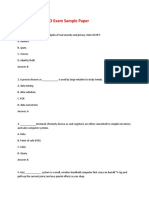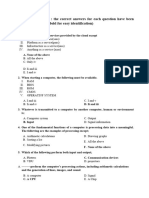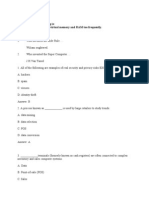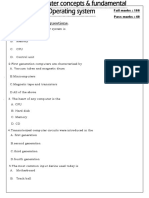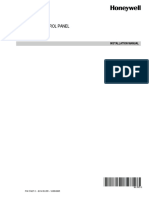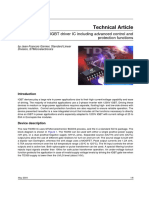0 ratings0% found this document useful (0 votes)
132 viewsTropical Medicare Institute: Introduction To Computer Assesment Test
TROPICAL MEDICARE INSTITUTE INTRODUCTION to computer ASSESSMENT TEST INTRUCTION Answer all questions Circle the most correct alternative Date; 11th October 2010.
Uploaded by
richardnyeroCopyright
© Attribution Non-Commercial (BY-NC)
Available Formats
Download as DOC, PDF, TXT or read online on Scribd
0 ratings0% found this document useful (0 votes)
132 viewsTropical Medicare Institute: Introduction To Computer Assesment Test
TROPICAL MEDICARE INSTITUTE INTRODUCTION to computer ASSESSMENT TEST INTRUCTION Answer all questions Circle the most correct alternative Date; 11th October 2010.
Uploaded by
richardnyeroCopyright
© Attribution Non-Commercial (BY-NC)
Available Formats
Download as DOC, PDF, TXT or read online on Scribd
You are on page 1/ 7
TROPICAL MEDICARE INSTITUTE
INTRODUCTION TO COMPUTER ASSESMENT TEST
INTRUCTION Date; 11th October 2010
Answer all questions
Circle the most correct alternative
1. Which device is used as the standard pointing device in a Graphical User Environment?
A. Keyboard
B. Mouse
C. Joystick
D. Track ball
2. Which number system is usually followed in a typical 32-bit computer?
A. 2
B. 10
C. 16
D. 32
3. Which of the following is not an output device?
A. Scanner
B. Printer
C. Flat Screen
D. Touch Screen
4. Which of the following devices have a limitation that we can only access information to it but
cannot erase or modify it?
A. Floppy Disk
B. Hard Disk
C. Tape Drive
D. CDROM
5. Which of the following storage devices can store maximum amount of data?
A. Floppy Disk
B. Hard Disk
C. Compact Disk
D. Magneto Optic Disk
6. The programs which are as permanent as hardware and stored in ROM is known as
A. Hardware
B. Software
C. Firmware
D. ROMware
7. Memory is made up of
A. Set of wires
B. Set of circuits
C. Large number of cells
D. All of these
8. Primary memory stores
A. Data alone
B. Programs alone
C. Results alone
D. All of these
9. Which device can understand difference between data & programs?
A. Input device
B. Output device
C. Memory
D. Microprocessor
10. The contents of information are stored in
A. Memory data register
B. Memory address register
C. Memory access register
D. Memory arithmetic register
11. Memory unit is one part of
A. Input device
B. Control unit
C. Output device
D. Central Processing Unit
12. Which of the following device can store large amounts of data?
A. Floppy Disk
B. Hard Disk
C. CDROM
D. Zip Disk
13. Data (information) is stored in computers as
A. Files
B. Directories
C. Floppies
D. Matter
14. Which of the memories below is often used in a typical computer operation?
A. RAM
B. ROM
C. FDD
D. HDD
15. MOS stands for _____
A. Metal Oxide Semiconductor
B. Most Often Store
C. Method Organized Stack
D. None of these
16. Which of the following statements is/are true?
A. Cache Memories are bigger than RAM
B. Cache Memories are smaller than RAM
C. ROM is faster than RAM
D. Information in ROM can be written by users
17. Which of the following is NOT one of the four major data processing functions of a
computer?
A. gathering data
B. processing data into information
C. analyzing the data or information
D. storing the data or information
18. Technology no longer protected by copyright, available to everyone, is considered to be:
A. proprietary
B. open
C. experimental
D. in the public domain
19. ____________ is data that has been organized or presented in a meaningful fashion.
A. A process
B. Software
C. Storage
D. Information
20.The name for the way that computers manipulate data into information is called:
A. programming
B. processing
C. storing
D. organizing
21. Computers gather data, which means that they allow users to ____________ data.
A. present
B. input
C. output
D. store
22. After a picture has been taken with a digital camera and processed appropriately, the actual
print of the picture is considered:
A. data
B. output.
C. input.
D. the process
23. Computers use the ____________ language to process data.
A. processing
B. kilobyte
C. binary
D. representational
24. Computers process data into information by working exclusively with:
A. multimedia
B. words
C. characters
D. numbers
25. In the binary language each letter of the alphabet, each number and each special character is
made up of a unique combination of:
A. eight bytes
B. eight kilobytes
C. Eight characters
D. eight bit
26. The term bit is short for:
A. megabyte
B. binary language
C. binary digit
D. binary number
27. A string of eight 0s and 1s is called a:
A. megabyte
B. byte
C. kilobyte
D. gigabyte
28. A ____________ is approximately one billion bytes.
A. kilobyte
B. bit
C. gigabyte
D. megabyte
29. A ____________ is approximately a million bytes.
A. gigabyte
B. kilobyte
C. megabyte
D. terabyte
30. ____________ is any part of the computer that you can physically touch.
A. Hardware
B. A device
C. A peripheral
D. An application
31. The components that process data are located in the:
A. input devices.
B. output devices.
C. system unit
D. storage component
32. All of the following are examples of input devices EXCEPT a:
A. scanner
B. mouse
C. keyboard
D. printer
33. Which of the following is an example of an input device?
A. scanner
B. speaker
C. CD
D. printer
34. All of the following are examples of storage devices EXCEPT:
A. hard disk drives.
B. printers
C. floppy disk drives.
D. CD drives.
35. The ____________, also called the brainsン of the computer, is responsible for processing
data.
A. motherboard
B. memory
C. RAM
D. central processing unit (CPU)
36. The CPU and memory are located on the:
A. expansion board
B. motherboard
C. storage device
D. output device.
37. Word processing, spreadsheet, and photo-editing are examples of:
A. application software
B. system software
C. operating system software
D. platform software
38. ____________ is a set of computer programs used on a computer to help perform tasks.
A. An instruction
B. Software.
C. Memory
D. A processor
39. System software is the set of programs that enables your computer hardware devices and
____________ software to work together.
A. management
B. processing
C. utility
D. application
40. Apple Macintoshes (Macs) and PCs use different ____________ to process data and different
operating systems.
A. languages
B. methods
C. CPUs.
D. storage devices
41. Which of the following is the correct order of the four major functions of a computer?
A. Process à Output à Input à Storage
B. Input à Outputà Process à Storage
C. Process à Storage à Input à Output
D. Input à Process à Output à Storage
42. ____________ bits equal one byte.
A. Eight
B. Two
C. One thousand
D. One million
43. The binary language consists of ____________ digit(s).
A. 8
B. 2
C. 1,000
D. 1
44. A byte can hold one ____________ of data.
A. bit
B. binary digit
C. character
D. kilobyte
45. The operating system is the most common type of ____________ software.
A. communication
B. application
C. system
D. word-processing software
46. The steps and tasks needed to process data, such as responses to questions or clicking an icon
are called:
A. instructions
B. the operating system
C. application software
D. the system unit
47. The two broad categories of software are:
A. word processing and spreadsheet
B. transaction and application
C. Windows and Mac OS
D. system and application
48. The metal or plastic case that holds all the physical parts of the computer is the:
A. system unit
B. CPU.
C. mainframe
D. platform
49. Match the following terms with their meanings:
I. printer A. storage device
II. Scanner B. output device
III. RAM C. input device
IV. CPU D. a type of memory
V. CD drive E. processor
Answer: B, C, D, E, A
50. Match the following terms with their meanings:
I. Data A. the main circuit board in the system unit
II. Memory B. the representation of a fact or idea (unprocessed information)
III. Output C. processed data or information
IV. Storage D. holds instructions or data that the CPU processes
V. Motherboard E. data or information that can be accessed again
Answer: B, D, C, E, A
You might also like
- Important Multiple Choice Questions: Computer System100% (4)Important Multiple Choice Questions: Computer System14 pages
- Grade 8 and 9 Handling Examination Question Presentation63% (8)Grade 8 and 9 Handling Examination Question Presentation46 pages
- Basic MCQs of Computer Science (IT) For NTS, PPSC & PCS Test, Computer Science Past Papers 2017, Computer Science Guess Papers 2017 - The Info Gate100% (3)Basic MCQs of Computer Science (IT) For NTS, PPSC & PCS Test, Computer Science Past Papers 2017, Computer Science Guess Papers 2017 - The Info Gate8 pages
- CompTIA A+ Certification All-in-One Exam Questions Prep (220-701 & 220-702)From EverandCompTIA A+ Certification All-in-One Exam Questions Prep (220-701 & 220-702)2.5/5 (6)
- Computer Basics: 100 Sample Questions (Solved)No ratings yetComputer Basics: 100 Sample Questions (Solved)30 pages
- Computer Studies Section A Problem - 051621100% (1)Computer Studies Section A Problem - 05162125 pages
- Computer General Knowledge For Bank ExaminationNo ratings yetComputer General Knowledge For Bank Examination11 pages
- Computer General Knowledge For Bank PO ExamNo ratings yetComputer General Knowledge For Bank PO Exam18 pages
- PPSC Computer Science Past Papers Mcqs PDFNo ratings yetPPSC Computer Science Past Papers Mcqs PDF16 pages
- Grade 8 and 9 Handling Examination Question Presentation100% (1)Grade 8 and 9 Handling Examination Question Presentation31 pages
- Basic Computer Questions and Answers 21.02.2019No ratings yetBasic Computer Questions and Answers 21.02.201945 pages
- Computer General Knowledge For Bank ExaminationNo ratings yetComputer General Knowledge For Bank Examination21 pages
- Question Bank For Computer For Digital EraNo ratings yetQuestion Bank For Computer For Digital Era49 pages
- A. Multiple Choice Questions.: Full Marks: 100 Pass Marks: 40No ratings yetA. Multiple Choice Questions.: Full Marks: 100 Pass Marks: 408 pages
- Which of The Following Is NOT A Hardware of A Computer?: A. Windows B. Monitor C. Central Processing Unit D. Key BoardNo ratings yetWhich of The Following Is NOT A Hardware of A Computer?: A. Windows B. Monitor C. Central Processing Unit D. Key Board16 pages
- Fundamentals Computer MCQ Collection HIMANSHU SHARMA100% (3)Fundamentals Computer MCQ Collection HIMANSHU SHARMA74 pages
- Industrial Pneumatics Basics - by CEREBRO SWITCH-desbloqueadoNo ratings yetIndustrial Pneumatics Basics - by CEREBRO SWITCH-desbloqueado80 pages
- Rain Detector Sensor: Shri Shankaracharya Institute of Professional Management & Technology, Raipur100% (2)Rain Detector Sensor: Shri Shankaracharya Institute of Professional Management & Technology, Raipur15 pages
- Technical Article: TD350 IGBT Driver IC Including Advanced Control and Protection FunctionsNo ratings yetTechnical Article: TD350 IGBT Driver IC Including Advanced Control and Protection Functions8 pages
- PRRU3801 Hardware Description V200 05 PDFNo ratings yetPRRU3801 Hardware Description V200 05 PDF30 pages
- Rigid Truck/Tractor: Average Visibility Average Visibility Average VisibilityNo ratings yetRigid Truck/Tractor: Average Visibility Average Visibility Average Visibility5 pages
- Product Catalogue: Telephone: +44 (0) 24 7646 6203 E-Mail: Sales@lawtontubes - Co.ukNo ratings yetProduct Catalogue: Telephone: +44 (0) 24 7646 6203 E-Mail: Sales@lawtontubes - Co.uk12 pages
- Use of Emergency Generator in Port SC152: Interpretations 1. GeneralNo ratings yetUse of Emergency Generator in Port SC152: Interpretations 1. General1 page
- Diris Digiware D 50 & D 70 Quick Start Guide 2022-02-549829 enNo ratings yetDiris Digiware D 50 & D 70 Quick Start Guide 2022-02-549829 en2 pages
- Solar Powered Automatic Pattern Design Grass Cutting Robot System Using ArduinoNo ratings yetSolar Powered Automatic Pattern Design Grass Cutting Robot System Using Arduino44 pages
- Sistema de Suministro de Energìa Electrica de AeronavesNo ratings yetSistema de Suministro de Energìa Electrica de Aeronaves4 pages
- Important Multiple Choice Questions: Computer SystemImportant Multiple Choice Questions: Computer System
- Grade 8 and 9 Handling Examination Question PresentationGrade 8 and 9 Handling Examination Question Presentation
- Basic MCQs of Computer Science (IT) For NTS, PPSC & PCS Test, Computer Science Past Papers 2017, Computer Science Guess Papers 2017 - The Info GateBasic MCQs of Computer Science (IT) For NTS, PPSC & PCS Test, Computer Science Past Papers 2017, Computer Science Guess Papers 2017 - The Info Gate
- CompTIA A+ Certification All-in-One Exam Questions Prep (220-701 & 220-702)From EverandCompTIA A+ Certification All-in-One Exam Questions Prep (220-701 & 220-702)
- Grade 8 and 9 Handling Examination Question PresentationGrade 8 and 9 Handling Examination Question Presentation
- A. Multiple Choice Questions.: Full Marks: 100 Pass Marks: 40A. Multiple Choice Questions.: Full Marks: 100 Pass Marks: 40
- Which of The Following Is NOT A Hardware of A Computer?: A. Windows B. Monitor C. Central Processing Unit D. Key BoardWhich of The Following Is NOT A Hardware of A Computer?: A. Windows B. Monitor C. Central Processing Unit D. Key Board
- Fundamentals Computer MCQ Collection HIMANSHU SHARMAFundamentals Computer MCQ Collection HIMANSHU SHARMA
- Computer Knowledge Bit Bank for All Competitive ExamsFrom EverandComputer Knowledge Bit Bank for All Competitive Exams
- Foundation Course for Advanced Computer StudiesFrom EverandFoundation Course for Advanced Computer Studies
- Industrial Pneumatics Basics - by CEREBRO SWITCH-desbloqueadoIndustrial Pneumatics Basics - by CEREBRO SWITCH-desbloqueado
- Rain Detector Sensor: Shri Shankaracharya Institute of Professional Management & Technology, RaipurRain Detector Sensor: Shri Shankaracharya Institute of Professional Management & Technology, Raipur
- Technical Article: TD350 IGBT Driver IC Including Advanced Control and Protection FunctionsTechnical Article: TD350 IGBT Driver IC Including Advanced Control and Protection Functions
- Rigid Truck/Tractor: Average Visibility Average Visibility Average VisibilityRigid Truck/Tractor: Average Visibility Average Visibility Average Visibility
- Product Catalogue: Telephone: +44 (0) 24 7646 6203 E-Mail: Sales@lawtontubes - Co.ukProduct Catalogue: Telephone: +44 (0) 24 7646 6203 E-Mail: Sales@lawtontubes - Co.uk
- Use of Emergency Generator in Port SC152: Interpretations 1. GeneralUse of Emergency Generator in Port SC152: Interpretations 1. General
- Diris Digiware D 50 & D 70 Quick Start Guide 2022-02-549829 enDiris Digiware D 50 & D 70 Quick Start Guide 2022-02-549829 en
- Solar Powered Automatic Pattern Design Grass Cutting Robot System Using ArduinoSolar Powered Automatic Pattern Design Grass Cutting Robot System Using Arduino
- Sistema de Suministro de Energìa Electrica de AeronavesSistema de Suministro de Energìa Electrica de Aeronaves

















